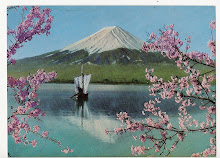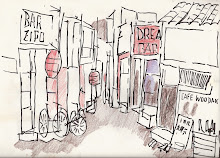
The Japanese Paleolithic age covers a lengthy period starting from around 100,000 to 30,000 B.C., when the earliest stone tool implements would have been found, and ending sometime around 12,000 B.C., at the end of the last ice age.
This timeline corresponds with the beginning of the Mesolithic Jōmon period. As the The Jōmon period has a start date of around 35,000 B.C, it is most generally accepted.[2]
The Japanese archipelago would become disconnected from the mainland continent after the last ice age, around 11,000 BC. After a hoax by an amateur researcher, Shinichi Fujimura, had been exposed,[3] the Lower and Middle Paleolithic evidence reported by Fujimura and his associates has been rejected after thorough reinvestigation.
As a result of the fallout over the hoax, now only some Upper Paleolithic evidence (not associated with Fujimura) can possibly be considered as having been well established.
[edit] Ancient Japan
[edit] Jōmon period

A Middle Jōmon vessel (3000–2000 BC)
Main article:
Jōmon periodThe Jōmon period lasted from about 14,000 BC until 500 BC. The first signs of civilization and stable living patterns appeared around 14,000 BC with the Jōmon culture, characterized by a Mesolithic to Neolithic semi-sedentary hunter-gatherer lifestyle of wood stilt house and pit dwellings and a rudimentary form of agriculture.
Weaving was still unknown at the time and clothes were often made of furs. The Jōmon people started to make clay vessels, decorated with patterns made by impressing the wet clay with braided or unbraided cord and sticks. Based on radio-carbon dating, some of the oldest surviving examples of pottery in the world can be found in Japan along with daggers, jade, combs made of shells, and varios other household items dated to the 11th millennium BC.[4]
Alternatively, the Metropolitan Museum of Art's Timeline of Art History [5] notes "Carbon-14 testing of the earliest known shards has yielded a production date of about 10,500 BC, but because this date falls outside the known chronology of pottery development elsewhere in the world, such an early date is not generally accepted.[6]
Calibrated radiocarbon measures of carbonized material from pottery artifacts: Fukui Cave 12500 +/− 350 BP and 12500 +/− 500 BP (Kamaki & Serizawa 1967), Kamikuroiwa rock shelter 12, 165 +/-350 years BP in Shikoku .[7] although the specific dating is disputed.
Clay figures known as dogū were also excavated. The household items suggest trade routes existed with places as far away as Okinawa.[citation needed] DNA analysis suggests that the Ainu, an indigenous people that live in Hokkaidō and the northern part of Honshū, are descended from the Jōmon and thus represent descendants of the first inhabitants of Japan.[citation needed]
[edit] Yayoi period
Main article:
Yayoi period 
A Yayoi period
Dōtaku, 3rd century AD
The Yayoi period lasted from about 400 or 300 BC to AD 250. This period followed the Jōmon period and completely supplanted it. This period is named after Yayoi town, the subsection of Bunkyō, Tokyo, where archaeological investigations uncovered its first recognized traces.
The start of the Yayoi period marked the influx of new practices such as weaving, rice farming, shamanism,[citation needed] and iron and bronze-making. Bronze and iron appear to have been introduced simultaneously into Yayoi Japan. Iron was mainly used for agricultural and other tools; whereas, ritual and ceremonial artifacts were mainly made of bronze. Some casting of bronze and iron began in Japan by about 100 BC, but the raw materials for both metals were introduced from the Asian continent.
Japan first appeared in written records in AD 57 with the following mention in China's Book of the Later Han:[8] "Across the ocean from Lelang are the people of Wa. Formed from more than one hundred tribes, they come and pay tribute frequently". The book also recorded that Suishō, the king of Wa, presented slaves to the Emperor An of Han in 107. The Sanguo Zhi, written in the 3rd century, noted the country was the unification of some 30 small tribes or states and ruled by a shaman queen named Himiko of Yamataikoku.
During the Han and Wei dynasties, Chinese travelers to Kyūshū recorded its inhabitants and claimed that they were the descendants of the Grand Count (Tàibó) of the Wu. The inhabitants also show traits of the pre-sinicized Wu people with tattooing, teeth-pulling, and baby-carrying. The Sanguo Zhi records the physical descriptions which are similar to ones on haniwa statues, such as men with braided hair, tattooing, and women wearing large, single-piece clothing.
The
Yoshinogari site in Kyūshū is the most famous archaeological site of the Yayoi period and reveals a large settlement continuously inhabited for several hundred years. Archaeological excavation has shown the most ancient parts to be from around 400 BC. It appears the inhabitants had frequent communication with the mainland and trade relations. Today, some reconstructed buildings stand in the park on the archaeological site.[
c



















